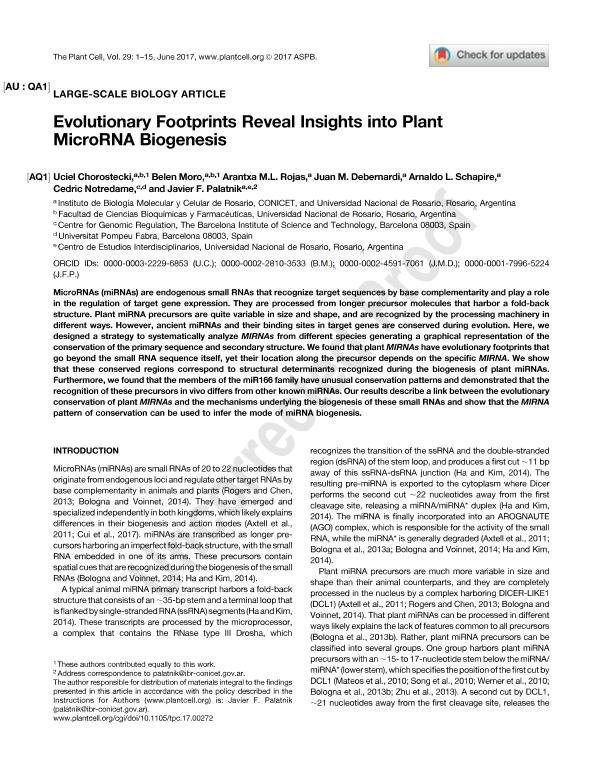Mostrar el registro sencillo del ítem
dc.contributor.author
Chorostecki, Uciel Pablo

dc.contributor.author
Moro, Belén

dc.contributor.author
Rojas, Arantxa Maria Larisa

dc.contributor.author
Debernardi, Juan Manuel

dc.contributor.author
Schapire, Arnaldo Luis

dc.contributor.author
Notredame, Cedric
dc.contributor.author
Palatnik, Javier Fernando

dc.date.available
2018-07-06T18:04:18Z
dc.date.issued
2017-06
dc.identifier.citation
Chorostecki, Uciel Pablo; Moro, Belén; Rojas, Arantxa Maria Larisa; Debernardi, Juan Manuel; Schapire, Arnaldo Luis; et al.; Evolutionary footprints reveal insights into plant microRNA biogenesis; American Society of Plant Biologist; Plant Cell; 29; 6; 6-2017; 1248-1261
dc.identifier.issn
1040-4651
dc.identifier.uri
http://hdl.handle.net/11336/51533
dc.description.abstract
MicroRNAs (miRNAs) are endogenous small RNAs that recognize target sequences by base complementarity and play a role in the regulation of target gene expression. They are processed from longer precursor molecules that harbor a fold-back structure. Plant miRNA precursors are quite variable in size and shape, and are recognized by the processing machinery in different ways. However, ancient miRNAs and their binding sites in target genes are conserved during evolution. Here, we designed a strategy to systematically analyze MIRNAs from different species generating a graphical representation of the conservation of the primary sequence and secondary structure. We found that plant MIRNAs have evolutionary footprints that go beyond the small RNA sequence itself, yet their location along the precursor depends on the specific MIRNA. We show that these conserved regions correspond to structural determinants recognized during the biogenesis of plant miRNAs. Furthermore, we found that the members of the miR166 family have unusual conservation patterns and demonstrated that the recognition of these precursors in vivo differs from other known miRNAs. Our results describe a link between the evolutionary conservation of plant MIRNAs and the mechanisms underlying the biogenesis of these small RNAs and show that the MIRNA pattern of conservation can be used to infer the mode of miRNA biogenesis.
dc.format
application/pdf
dc.language.iso
eng
dc.publisher
American Society of Plant Biologist

dc.rights
info:eu-repo/semantics/openAccess
dc.rights.uri
https://creativecommons.org/licenses/by-nc-sa/2.5/ar/
dc.subject
Micrornas
dc.subject
Evolucion
dc.subject
Precursores
dc.subject
Plantas
dc.subject.classification
Otras Ciencias Biológicas

dc.subject.classification
Ciencias Biológicas

dc.subject.classification
CIENCIAS NATURALES Y EXACTAS

dc.title
Evolutionary footprints reveal insights into plant microRNA biogenesis
dc.type
info:eu-repo/semantics/article
dc.type
info:ar-repo/semantics/artículo
dc.type
info:eu-repo/semantics/publishedVersion
dc.date.updated
2018-06-28T14:04:52Z
dc.journal.volume
29
dc.journal.number
6
dc.journal.pagination
1248-1261
dc.journal.pais
Estados Unidos

dc.journal.ciudad
Rockville
dc.description.fil
Fil: Chorostecki, Uciel Pablo. Consejo Nacional de Investigaciones Científicas y Técnicas. Centro Científico Tecnológico Conicet - Rosario. Instituto de Biología Molecular y Celular de Rosario. Universidad Nacional de Rosario. Facultad de Ciencias Bioquímicas y Farmacéuticas. Instituto de Biología Molecular y Celular de Rosario; Argentina
dc.description.fil
Fil: Moro, Belén. Consejo Nacional de Investigaciones Científicas y Técnicas. Centro Científico Tecnológico Conicet - Rosario. Instituto de Biología Molecular y Celular de Rosario. Universidad Nacional de Rosario. Facultad de Ciencias Bioquímicas y Farmacéuticas. Instituto de Biología Molecular y Celular de Rosario; Argentina
dc.description.fil
Fil: Rojas, Arantxa Maria Larisa. Consejo Nacional de Investigaciones Científicas y Técnicas. Centro Científico Tecnológico Conicet - Rosario. Instituto de Biología Molecular y Celular de Rosario. Universidad Nacional de Rosario. Facultad de Ciencias Bioquímicas y Farmacéuticas. Instituto de Biología Molecular y Celular de Rosario; Argentina
dc.description.fil
Fil: Debernardi, Juan Manuel. Consejo Nacional de Investigaciones Científicas y Técnicas. Centro Científico Tecnológico Conicet - Rosario. Instituto de Biología Molecular y Celular de Rosario. Universidad Nacional de Rosario. Facultad de Ciencias Bioquímicas y Farmacéuticas. Instituto de Biología Molecular y Celular de Rosario; Argentina
dc.description.fil
Fil: Schapire, Arnaldo Luis. Consejo Nacional de Investigaciones Científicas y Técnicas. Centro Científico Tecnológico Conicet - Rosario. Instituto de Biología Molecular y Celular de Rosario. Universidad Nacional de Rosario. Facultad de Ciencias Bioquímicas y Farmacéuticas. Instituto de Biología Molecular y Celular de Rosario; Argentina
dc.description.fil
Fil: Notredame, Cedric. The Barcelona Institute of Science and Technology; España. Universitat Pompeu Fabra; España
dc.description.fil
Fil: Palatnik, Javier Fernando. Consejo Nacional de Investigaciones Científicas y Técnicas. Centro Científico Tecnológico Conicet - Rosario. Instituto de Biología Molecular y Celular de Rosario. Universidad Nacional de Rosario. Facultad de Ciencias Bioquímicas y Farmacéuticas. Instituto de Biología Molecular y Celular de Rosario; Argentina. Universidad Nacional de Rosario. Centro de Estudios Interdisciplinarios; Argentina
dc.journal.title
Plant Cell

dc.relation.alternativeid
info:eu-repo/semantics/altIdentifier/doi/https://dx.doi.org/10.1105/tpc.17.00272
dc.relation.alternativeid
info:eu-repo/semantics/altIdentifier/url/http://www.plantcell.org/content/29/6/1248
Archivos asociados
